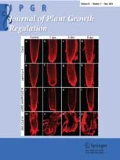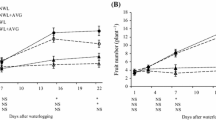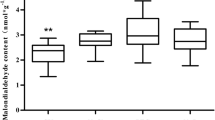Abstract
The current study investigated the effect of 1-methylcyclopropene (1-MCP), an ethylene inhibiting compound, in alleviating the detrimental effect of drought on cotton plants. The experiment was conducted in a growth chamber in 2006 and 2007. Treatments consisted of (T1) an untreated control well-watered, (T2) 1-MCP at 10 g ai/ha well-watered, (T3) an untreated control water-stressed, and (T4) 1-MCP at 10 g ai/ha water-stressed. Water-stress treatment consisted of withholding water from the pots until stomatal closure. The water-stress regime and the 1-MCP treatments were imposed at the pinhead-square stage, approximately 4 weeks after planting. Water-stressed plants treated with 1-MCP had a higher stomatal resistance, less negative water potential, higher activity of antioxidant enzymes, and better maintenance of membrane integrity. The greatest effects on stomatal resistance were observed at 5 days after treatment initiation, in which water-stressed 1-MCP-treated plants exhibited stomatal resistance of 0.079 m2 s mmol−1, whereas water-stressed untreated plants exhibited only 0.047 m2 s mmol−1. There was no significant effect of 1-MCP on water-use efficiency, transpiration, and dry matter production. These results indicated that application of 1-MCP to water-stressed cotton may have the potential to lower levels of stress in treated plants.






Similar content being viewed by others
References
Abeles FB, Morgan PW, Saltveit ME Jr (1992) Ethylene in plant biology, 2nd edn. Academic Press, San Diego, CA
Acharya BR, Assmann SM (2009) Hormone interactions in stomatal function. Plant Mol Biol 69:451–462
Apelbaum A, Yang SF (1981) Biosynthesis of stress ethylene induced by water deficit. Plant Physiol 68:594–596
Asada K (1999) The water-water cycle in chloroplast: scavenging of active oxygen and dissipation of excess photons. Ann Rev Plant Physiol Biol 50:601–639
Basal H, Smith CW, Thaxton PS, Hemphill JK (2005) Seedling drought tolerance in upland cotton. Crop Sci 45:766–771
Begg JE, Turner NC (1976) Crop water deficits. Adv Agron 28:161–217
Bellaire BA, Carmody J, Braud J, Gossett DR, Banks SW, Lucas MC, Fowler TE (2000) Involvement of abscisic acid-dependent and independent pathways in the upregulation of antioxidant enzyme activity during NaCl stress in cotton callus tissue. Free Radic Res 33:531–545
Binder BM, Bleecker AB (2003) A model for ethylene receptor function and 1-methylcyclopropene action. Acta Hortic 628:177–187
Blankenship SM, Dole JM (2003) 1-Methylcyclopropene: a review. Postharvest Biol Technol 28:1–25
Bot AJ, Nachtergaele FO, Young A (2000) Land resource potential and constraints at regional and country levels. World Soil Resources Reports 90. Land and Water Development Division, FAO, Rome
Bueno P, Piqueras A, Kurepa J, Savoure A, Verbruggen N, Van Montagu M, Inze D (1998) Expression of antioxidant enzymes in response to abscisic acid and high osmoticum in tobacco BY-2 cell cultures. Plant Sci 138:27–34
Burke JJ, Gamble PE, Hatfield JL, Quisenberry JE (1985) Plant morphological and biochemical responses to field water deficits. Plant Physiol 79:415–419
Chang-Cheng X, Qi Z (1993) Effect of drought on lipoxygenase activity, ethylene and ethane production in leaves of soybean plants. Acta Bot Sin 35:31–37
Davies WJ, Mansfield TA, Ortron PJ (1978) Strategies employed by plants to conserve water: can we improve them? Proc Brit Crop Protect Council 8:45–54
Desikan R, Last K, Harrett-Williams R, Tagliavia C, Harter K, Hooley R, Hancock JT, Neill SJ (2006) Ethylene-induced stomatal closure in Arabidopsis occurs via AtrbohF-mediated hydrogen peroxide synthesis. Plant J 47:907–916
Elstner EF (1991) Mechanisms of oxygen activation in different compartments of plant cells. In: Pell EJ, Steffen KL (eds) Active oxygen species, oxidative stress, and plant metabolism. American Society of Plant Physiologists, Rockville, MD, pp 13–25
Garrat LC, Janagoudar BS, Lowe KC, Anthony P, Power JB (2002) Salinity tolerance and antioxidant status in cotton cultures. Free Radic Biol Med 33:502–511
Gomez SK, Oosterhuis DM, Rajguru SN, Johnson DR (2004) Foliar antioxidant enzyme responses in cotton after aphid herbivory. J Cotton Sci 8:99–104
Gomez-Cadenas A, Tadeo FR, Talon M, Primo-Millo E (1996) Leaf abscission induced by ethylene in water-stressed intact seedlings of Cleopatra mandarin requires previous abscisic acid accumulation in roots. Plant Physiol 112:401–408
Gonias ED, Oosterhuis DM, Bibi AC (2008) Physiologic response of cotton to the insecticide imidacloprid under high-temperature stress. J Plant Growth Regul 27:77–82
Gosset DR, Millhollon EP, Lucas MC (1994) Antioxidant response to NaCl stress in salt-tolerant and salt-sensitive cultivars of cotton. Crop Sci 34:706–714
Grene R (2002) Oxidative stress and acclimation mechanisms in plants. In: Somerville CR, Myerowitz EM (eds) The Arabidopsis book. American Society of Plant Biologists, Rockville, MD. Available at http://www.aspb.org/publications/Arabidopsis/
Hua J, Meyerowitz EM (1998) Ethylene responses are negatively regulated by a receptor gene family in Arabidopsis thaliana. Cell 94:261–271
Jiang M, Zhang J (2001) Effect of abscisic acid on active oxygen leaves of maize seedlings. Plant Cell Physiol 42:1265–1273
Jiang M, Zhang J (2002a) Involvement of plasma-membrane NADPH oxidase in abscisic acid and water stress-induced antioxidant defense in leaves of maize seedlings. Planta 215:1022–1030
Jiang M, Zhang J (2002b) Water stress-induced abscisic acid accumulation triggers the increased generation of reactive oxygen species and up-regulates the activities of antioxidant in maize leaves. J Exp Bot 53:2401–2410
Lu Y, Foo LY (2000) Antioxidant and radical scavenging activities of polyphenols from apple pomace. Food Chem 68:81–85
Lu Y, Foo LY (2001) Antioxidant activities of polyphenols from sage (Salvia officinalis). Food Chem 75:197–202
Mahan JR, Wanjura DF (2005) Seasonal patterns of glutathione and ascorbate metabolism in field-grown cotton under water stress. Crop Sci 45:193–201
McMichael BL, Jordan WR, Powekk RD (1972) Effect of water stress on ethylene production by intact cotton petioles. Plant Physiol 49:658–662
McWilliams D (2003) Drought strategies for cotton. CES Circular 583, New Mexico State University
Meloni DA, Oliva MA, Maritnez CA, Cambraia J (2003) Photosynthesis and activity of superoxidase dismutase, peroxidase and glutathione reductase in cotton under salt stress. Environ Exp Bot 49:69–76
Miller G, Suzuki N, Ciftci-Yilmaz S, Mittler R (2009) Reactive oxygen species homeostasis and signaling during drought and salinity stresses. Plant Cell Environ (in press)
Morgan PW (1990) Effects of abiotic stress on plant hormone systems. In: Alscher R, Cummings J (eds) Stress responses in plants: adaptation mechanisms. Wiley-Liss, New York, pp 313–314
Morgan PW, Drew M (1997) Ethylene and plant responses to stress. Physiol Plant 100:620–630
Oosterhuis DM (2003) Psychrometry for Measuring Plant and Soil Water Status: Theory, Types and Uses. In: Stewart BA, Howell T (eds) Encyclopedia of water science. Marcel Dekker, New York, pp 751–755
Pace PF, Cralle HT, El-Halawany SH, Cothren JT, Senseman SA (1999) Drought-induced changes in shoot and root growth of young cotton plants. J Cotton Sci 3:183–187
Pierik R, Sasidharan R, Voesenek LAC (2007) Growth control by ethylene: adjusting phenotypes to the environment. J Plant Growth Regul 26:188–200
Prasad TK, Anderson MD, Stewart CR (1994) Acclimation, hydrogen peroxide, and abscisic acid protect mitochondria against irreversible chilling injury in maize seedlings. Plant Phyiol 105:619–627
Reddy AR, Chaitanya KV, Jutur PP, Sumithra K (2004) Differential antioxidative responses to water stress among five mulberry (Morus alba L.) cultivars. Environ Exp Bot 52:33–42
Sairam RK, Siiukla DS, Saxena DC (1997) Stress induced injury and antioxidant enzymes in relation to drought tolerance in wheat genotypes. Biol Plant 40:357–364
Sairam RK, Deshmukh PS, Saxena DC (1998) Role of antioxidant systems in wheat genotypes’ tolerance to water stress. Biol Plant 41:387–394
Scandalios JG (1997) Molecular genetics of superoxide dismutase in plants. In: Scandalios JG (ed) Oxidative Stress and Molecular Biology of Antioxidant Defenses. Cold Spring Harbor Laboratory Press, Cold Spring Harbor, NY, pp 527–568
Schaedle M, Bassham JA (1977) Chloroplast glutathione reductase (in spinach). J Plant Physiol 59:1011–1012
Serek M, Tamari G, Sisler EC, Borochov A (1995) Inhibition of ethylene-induced cellular senescence symptoms by 1-methylcyclopropene, a new inhibitor of ethylene action. Physiol Plant 94:229–232
Sharp RE (2002) Interaction with ethylene: changing views on the role of abscisic acid in roots and shoot growth responses to water stress. Plant Cell Environ 25:211–222
Sharp RE, Poroyko V, Hejlek LG, Spollen WG, Springer GK, Bohnert HJ, Nguyen HT (2004) Root growth maintenance during water deficits: physiology to functional genomics. J Exp Bot 55:2343–2351
Sisler EC, Serek M (1997) Inhibitors of ethylene responses in plants at the receptor level: recent developments. Physiol Plant 100:577–582
Spollen WG, LeNoble ME, Samuels TD, Bernstein N, Sharp RE (2000) Abscisic acid accumulation maintains maize primary root elongation and low water potential by restricting ethylene production. J Plant Physiol 122:967–976
Sobeih WY, Dodd IC, Bacon MA, Grierson D, Davies WJ (2004) Long-distance signals regulating stomatal conductance and leaf growth in tomato (Lycopersicon esculentum) plants subjected to partial root-zone drying. J Exp Bot 55:2353–2363
Suttle JC, Kende H (1980) Ethylene action and loss of membrane integrity during petal senescence in Tradescantia. J Plant Physiol 65:1067–1072
Tanaka Y, Sano T, Tamaoki M, Nakajima N, Kondo N, Hasezawa S (2005) Ethylene inhibits abscisic acid-induced stomatal closure in Arabidopsis. Plant Physiol 138:2337–2343
Thompson JE, Mayak S, Shinitzky M, Halevy A (1982) Acceleration of membrane senescence in cut carnation flowers by treatment with ethylene. Plant Physiol 69:859–863
Turner NC (1997) Further progress in crop water relations. Adv Agron 58:293–338
Wang Y, Sun G, Suo B, Chen G, Wang J, Yan Y (2008) Effects of Na2CO3 and NaCl stresses on the antioxidant enzymes of chloroplasts and chlorophyll fluorescence parameters of leaves Puccinellia tenuiflora (Turcz.) scribn. et Merr. Acta Physiol Plant 30:143–150
Wilkison S, Davies WJ (2009) Ozone suppresses soil drying and abscisic acid (ABA)-induced stomatal closure via an ethylene-dependent mechanism. Plant Cell Environ 32:949–959
Young TE, Meeley RB, Gallie DR (2004) ACC synthase expression regulates leaf performance and drought tolerance in maize. Plant J 40:813–825
Acknowledgment
We thank the University of Arkansas Agricultural Research and Extension Center for supporting this research and Agrofresh Inc. for partial funding of this research.
Author information
Authors and Affiliations
Corresponding author
Rights and permissions
About this article
Cite this article
Kawakami, E.M., Oosterhuis, D.M. & Snider, J.L. Physiological Effects of 1-Methylcyclopropene on Well-Watered and Water-Stressed Cotton Plants. J Plant Growth Regul 29, 280–288 (2010). https://doi.org/10.1007/s00344-009-9134-3
Received:
Accepted:
Published:
Issue Date:
DOI: https://doi.org/10.1007/s00344-009-9134-3




